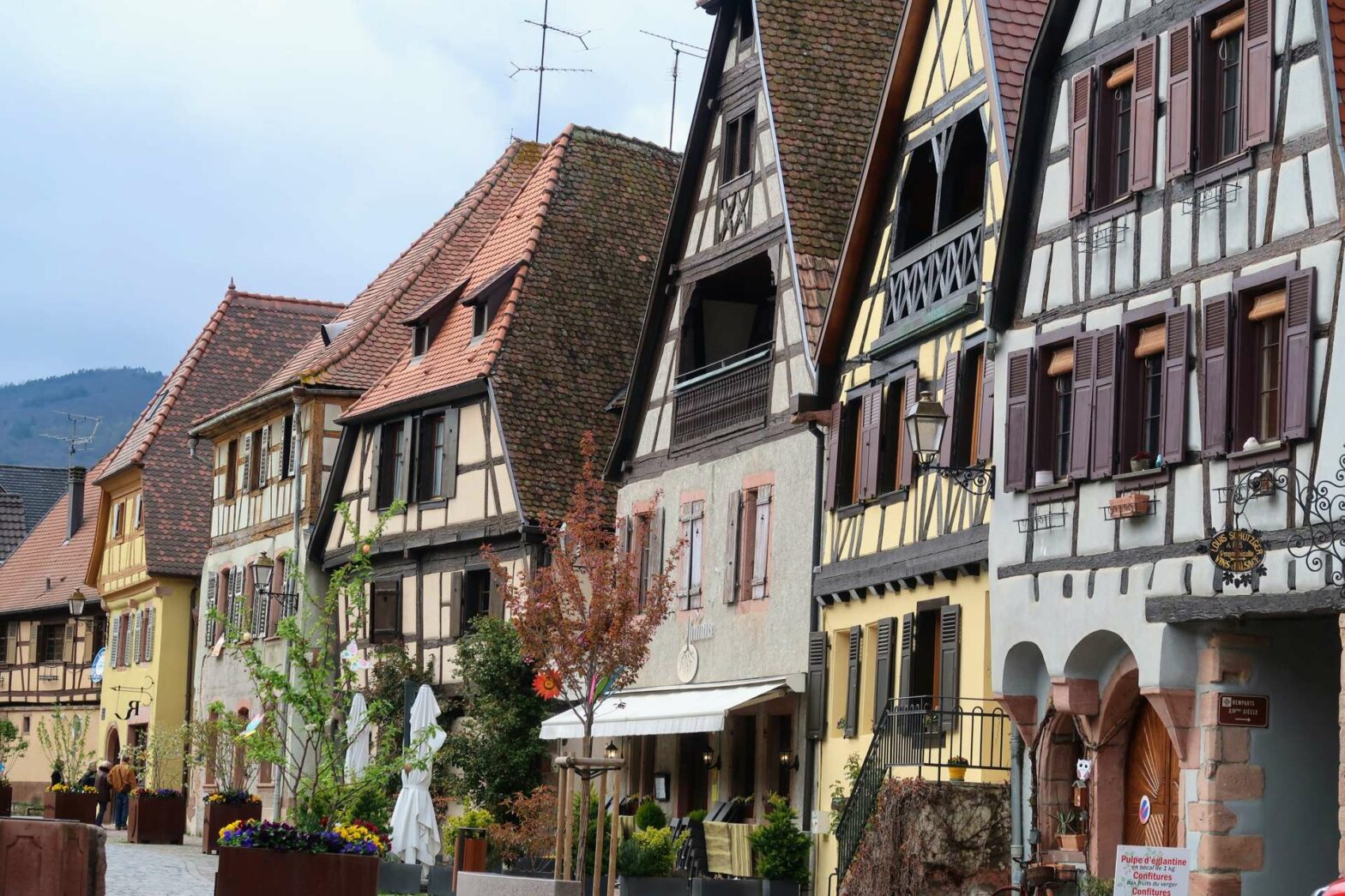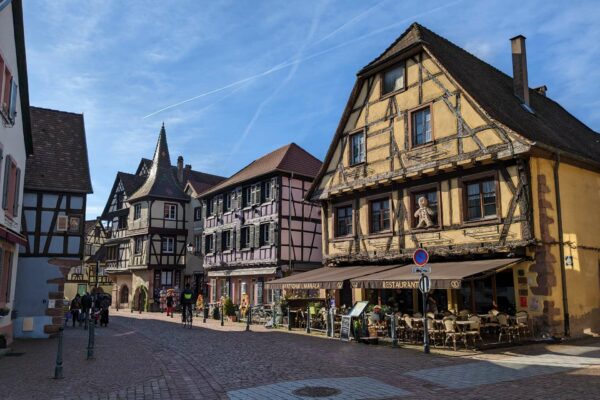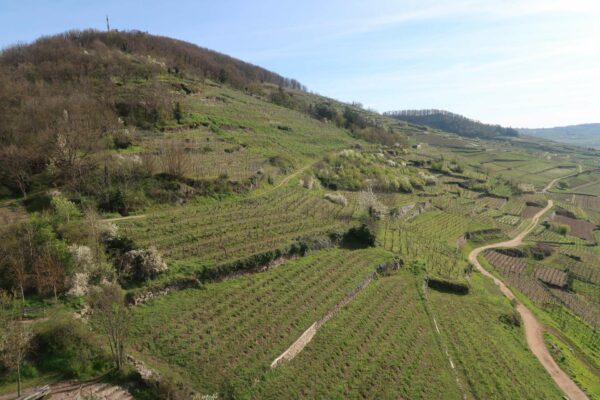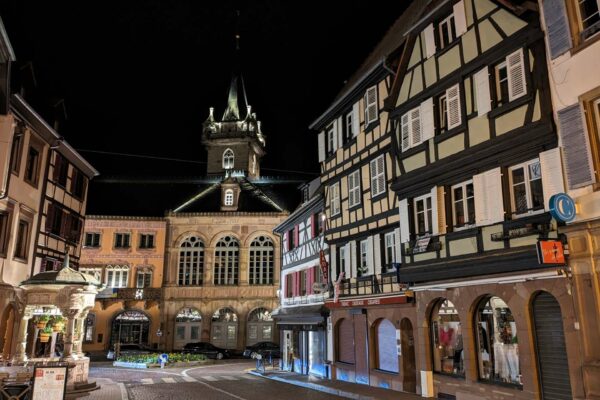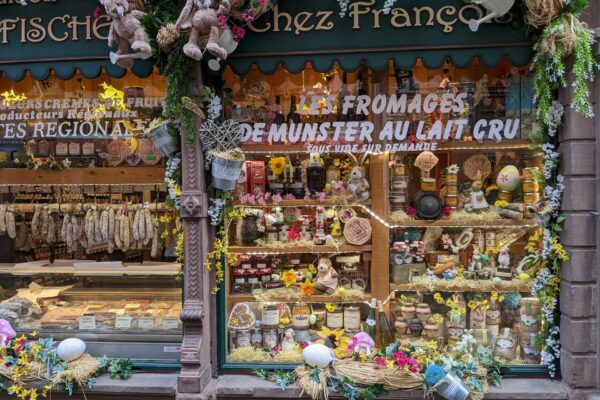By Vicky · Published Aug. 30th, 2023 · Updated Apr. 3rd, 2024
When you buy through links highlighted with an asterisk (*) on this site, we may earn a small affiliate commission at no cost to you.
The Alsace Wine Route is a famous wine route in Alsace renowned for its stunning landscapes, charming villages, and exceptional wines. The route stretches for about 170 kilometers (106 miles) through the heart of Alsace, from Marlenheim in the north to Thann in the south. Read on to find the route map, how to explore the Alsace Wine Route by car or train, and a suggested itinerary.
Page Contents:
Alsace Wine Route Map
Get the route by downloading the .gpx or .kml file below. For navigation with Maps.me on your mobile phone, simply download the .kml file and open to add it to the Maps.me bookmarks.
Tips
- Summer and over Christmas are the busiest periods, but long weekends such as Easter can also get busy. Book accommodation and restaurants in advance during these times.
- Try and visit some of the smaller villages as well as the more famous ones.
- Don’t just walk through the villages, but explore the surrounding countryside to fully appreciate the region.
- Start early to avoid the crowds!
- Most tourist information offices in the villages have maps of the entire Alsace Wine Route. These may be closed on Sundays or out of season.
- For more places to visit in France, check out our France Guide.
Alsace Wine Tour Highlights
On a tour of the Alsace Wine Route, you’ll wind through some of Alsace’s most beautiful vineyard landscapes and lovely villages. Make sure to check out the highlights below:
Wine: The region is particularly known for its white wines, including Riesling, Gewürztraminer, Pinot Gris, and Muscat. Many wineries along the route offer tastings and tours to visitors. These are best done at the end of the day when you no longer have to drive.
Charming Villages: The route passes through numerous picturesque villages, each with its own unique character. These villages often have half-timbered houses, cobblestone streets, and flower-decked windowsills. Some notable villages along the route include Riquewihr, Ribeauvillé, Eguisheim, and Kaysersberg. For a complete list, check out the Best Villages in Alsace.
Gastronomy: In addition to wine, the Alsace region is known for its culinary delights. Visitors can savor traditional Alsatian dishes such as tarte flambée (a type of flatbread topped with various ingredients), choucroute garnie (sauerkraut with sausages and other meats), and baeckeoffe (a hearty meat and potato casserole).
Scenic Views: The route offers breathtaking views of the Vosges Mountains on one side and the Alsatian plains on the other. The landscape changes with the seasons, making it a picturesque destination year-round.
Outdoor Activities: Beyond wine and food, the region also offers opportunities for outdoor activities like hiking, biking, and exploring the natural beauty of the area. Check out the best walks in Alsace if you want to get active and soak in the countryside.
Villages on the Alsace Wine Route
For a full description and walking tour of each village, click on the links beneath the photos. Alternatively, check out the Best Villages in Alsace, or find the Best Places to Stay in Alsace. Apart from the villages mentioned below, another highlight of the Alsace Wine Route is a trip to Château Haut-Koenigsbourg, a grand castle on the hills overlooking the valley.
Alsace wine route by car
A road trip with a car or camper along the Alsace Wine Route is the easiest way to explore the region. However, public transport is also a decent option (see below). The roads in Alsace are generally quiet, though queues can build up in peak season near the most popular locations. These include Ribeauvillé, Riquewihr, Kayserberg, Eguisheim and at Château Haut-Koenigsbourg.
In some villages you can find free parking, though most have a paid car park at one or both ends of town. Prices vary from a couple of euros to more than 5 euros depending on the village, which can add up if you visit several villages during the day.
If you’re visiting Alsace at a warmer time of year, traveling by car can give you the option of camping. There are plenty of campsites in the region, and many villages have their own municipal camping on the edge of town. This means you can park at the campsite and simply walk into town. Do remember to book campsites in advance in busier times (especially if you have a larger camper rather than just a small tent). See here for a list of the best campsites in Alsace.
Alsace wine route by train
It’s quite easy to explore the Alsace Wine Route without a car using a combination of trains and buses. There’s a direct train connection between Strasbourg and Colmar. It takes about 30 minutes, with most trains also stopping halfway at Sélestat. Since Strasbourg, Colmar and Sélestat are hubs of public transport, it makes sense to base yourself in one of these towns. Check out the Best Places to Stay in Alsace.
Strasbourg to Sélestat local train
Most of the villages on the Alsace wine route north of Sélestat can easily be reached on the train between Strasbourg and Sélestat. This train leaves Strasbourg and first heads to Molsheim, Obernai, then continues to Barr, Dambach la Ville and finally to Sélestat.
Château Haut-Koenigsbourg without a car
To get to Château Haut-Koenigsbourg without a car, you have to take the bus from Sélestat. The bus takes 30 minutes and leaves from Sélestat train station every hour. The bus returns back to Sélestat, from where you can continue your onward journey. However, there may be a long wait between buses/trains. If you have time to spare, go on a Walking Tour of Sélestat.
Bus to Villages between Sélestat and Colmar
South of Sélestat, there’s no train to the smaller villages but there is a bus. There’s a bus from Sélestat to the charming village of Ribeauvillé every hour. The bus itself takes around 25 minutes. In between, this bus stops at other smaller villages on the Alsace Wine Route such as Kintzheim, Saint Hyppolyte and Bergheim.
Heading further south, you have to change buses in Ribeauvillé. There is then a bus from Ribeauvillé heading all the way to Colmar (40 minutes). This is fairly infrequent so make sure to check the schedule in advance. This bus stops at other villages on the Alsace Wine Route such as Hunawihr and Riquewihr. It can also be more convenient to take the train to Colmar, and then the bus north to Riquewihr.
Bus from Colmar to other Villages
Other popular towns on the Alsace Wine Route include Kayserberg and Eguisheim. Unforunately, there is no direct connection between Riquewihr and Kayserberg. Even though they are quite close, you have to go into Colmar and then back out again. An alternative and often quicker option is to walk between Riquewihr and Kayserberg, roughly 5 km through sloping vineyards.
To get to Eguisheim, which is south of Colmar, there’s a direct bus from Colmar train station. The bus journey itself takes about 15 minutes, though the bus only leaves fairly infrequently, every 2 hours or so.
Alsace Wine Route Itinerary
The most popular section of the Alsace Wine Route is between Strasbourg and Colmar. You can find several Strasbourg to Colmar itineraries of different lengths by clicking on the links below. If you’re really pushed for time, an efficient way to see the area is on a one-day guided tour*.
Alsace Wine Route One Day Itinerary: If you only have one day, include Strasbourg, Ribeauvillé, Riquewihr, Eguisheim and Colmar.
Alsace Wine Route Two Day Itinerary: If you have two days, you can include the villages mentioned above, plus Obernai and Château Haut-Koenigsbourg
Alsace Wine Route Three Day Itinerary: To spend three days in Alsace, add on to the places above Bergheim, Kayserberg, and Katzental.
A Week in Alsace: If you have an entire week in Alsace, you can fully explore the region, including some walks and hikes in the nearby hills.
Alsace Wine Route How Many Days?
As you can see from the itineraries above, if you spend more days in Alsace you can obviously visit more places. I’d recommend spending at least three days traveling along the Alsace Wine Route. You’ll be able to see the main highlights without feeling too rushed. However, you could easily spend a week here. Then you could explore both Strasbourg, Colmar, and most of the cute villages in between. There are also some great walks in Alsace if you want a break from seeing villages!

